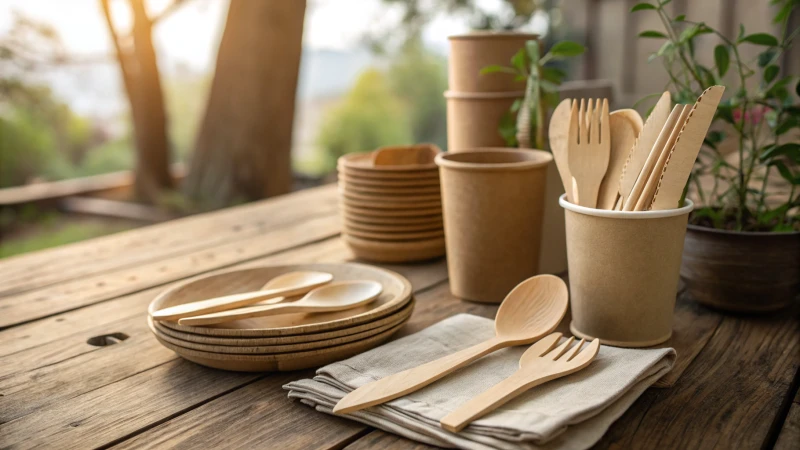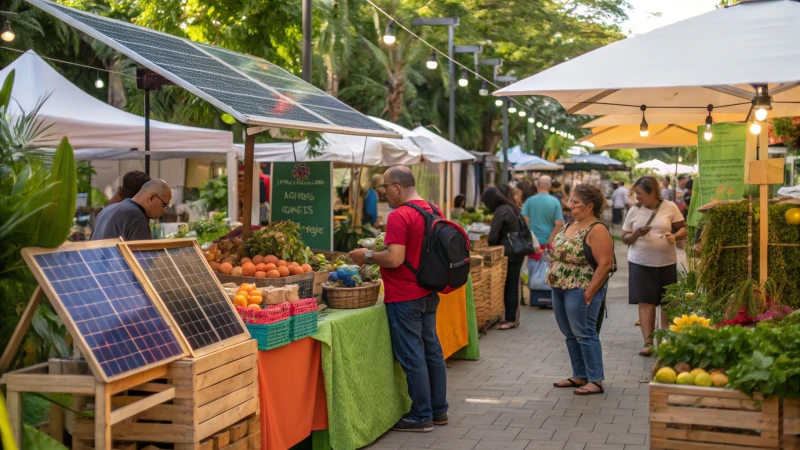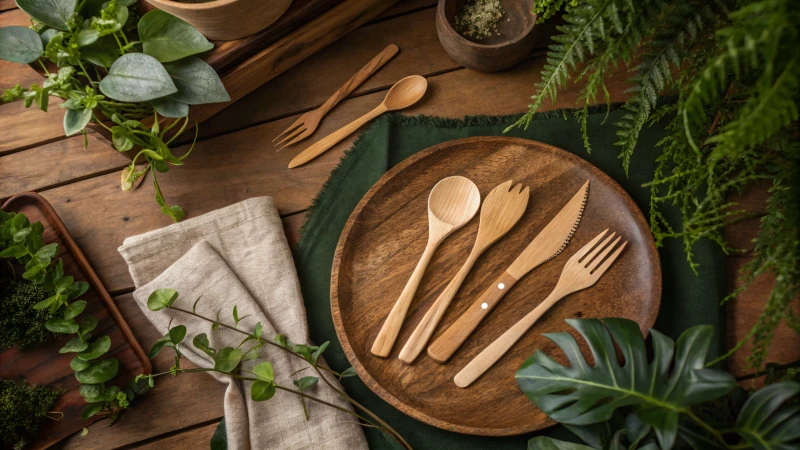
Ever felt like saving the planet could be as simple as swapping your fork? Turns out, it can be!
The disposable wooden cutlery market is set to thrive as environmental consciousness and regulatory pressures rise. With consumers demanding sustainable alternatives, this market is poised for significant growth driven by eco-awareness and policies favoring biodegradable products.
Reflecting on my journey into sustainability, I remember the moment I swapped plastic for wood in my own kitchen. It felt like a small victory in my battle against waste. This personal shift mirrors a global trend where businesses are increasingly leaning towards eco-friendly solutions like disposable wooden cutlery.
Imagine walking into a restaurant and seeing beautiful, crafted wooden utensils instead of plastic ones. For me, it’s more than just aesthetics—it's about making a statement. As more regions adopt stringent environmental regulations, the demand for these biodegradable options is skyrocketing. Companies that align themselves with these values are not just riding a trend; they’re leading a movement.
While the initial answer captures the essence of this growing market, diving deeper into the regional differences, consumer preferences, and industry innovations can unveil strategic insights. Understanding these nuances is key to harnessing the potential of this promising market and redefining business strategies in line with sustainability goals.
Disposable wooden cutlery demand is driven by eco-awareness.True
Increased environmental consciousness among consumers boosts demand for sustainable products.
Government policies do not affect the cutlery market growth.False
Stringent regulations favoring biodegradable options significantly impact market expansion.
How Do Environmental Regulations Affect Market Demand?
Ever feel like the world is shifting beneath your feet? That’s how market dynamics are evolving under the weight of environmental regulations.
Environmental regulations reshape market demand by pushing industries toward innovation and sustainability. This change encourages consumers to prefer eco-friendly products, aligning business practices with environmental objectives.

The Rise of Sustainable Products
I remember walking into a store and seeing the explosion of electric vehicles and biodegradable packaging everywhere. It wasn't just a trend; it was a revolution, driven by environmental regulations. These rules have become the invisible hand guiding industries to cut carbon emissions and tread lightly on our planet. In the automotive sector, for instance, it's incredible how quickly electric vehicles have taken over, fueled by emission standards and generous incentives.
Environmental regulations have catalyzed the rise of sustainable products. As governments implement stricter policies, industries are pressured to reduce carbon footprints and enhance sustainability. This shift is evident in sectors like automotive, where electric vehicles have gained popularity due to incentives and emission standards1. Similarly, the packaging industry is transitioning towards biodegradable materials.
| Industry | Regulation Impact |
|---|---|
| Automotive | Shift to electric vehicles |
| Packaging | Increase in biodegradable materials |
| Energy | Growth in renewable energy sources |
Consumer Behavior Changes
I've noticed a significant change in my shopping habits, and I bet I'm not alone. More and more, people are reaching for products that promise a lighter footprint on Earth. Companies are responding by crafting green packaging, especially as single-use plastics are phased out in favor of alternatives like wooden cutlery2.
Environmental awareness among consumers is reshaping market dynamics. People are increasingly opting for eco-friendly products, influencing how companies operate. For example, brands are focusing on creating green packaging to attract eco-conscious buyers. The trend is supported by regulations that restrict single-use plastics.
Innovation in Business Practices
Seeing businesses pivot to clean energy and sustainable supply chains is inspiring. It's not just about meeting regulatory demands; it's about building a brand that stands for something meaningful. Companies embracing renewables aren't just ticking boxes; they're gaining tax benefits and a competitive edge3 in the marketplace.
Businesses are innovating to comply with environmental standards. This innovation extends beyond product lines to operational practices, such as adopting clean energy and sustainable supply chains. These practices not only meet regulatory requirements but also enhance brand image and customer loyalty.
Market Opportunities and Challenges
While these regulations open doors to new opportunities, they come with their share of hurdles. Investing in research and development is crucial to comply, but it's not cheap. However, as I've seen, the long-term gains—new markets, consumer trust—make it all worthwhile.
Industries like textiles and electronics are seeing increased demand for eco-friendly products yet face challenges in sourcing sustainable materials.
Regulatory Influence Across Regions
Globally, the landscape varies. In Europe, stringent policies are propelling renewable energy forward at an impressive pace. Meanwhile, in Asia, waste management innovation is taking center stage.
The impact of environmental regulations varies globally; each region's unique regulatory environment shapes its market trends uniquely,
emphasizing the importance of global collaboration4 to address environmental challenges effectively.
Stricter regulations increase electric vehicle demand.True
Regulations on emissions boost electric vehicle popularity.
Biodegradable materials are declining in packaging.False
Packaging industry is increasing biodegradable material use.
What Consumer Trends Are Driving Growth in Wooden Cutlery?
Have you ever wondered why wooden cutlery is becoming the go-to choice for eco-conscious consumers?
The surge in wooden cutlery demand is driven by consumers' preference for eco-friendly products, heightened environmental consciousness, and tighter regulations on single-use plastics. These trends reflect a broader commitment to sustainability and reducing plastic waste.

Eco-Conscious Consumerism
I remember the first time I held a wooden spoon at a local café; it felt like a small but significant step towards making a difference. This personal experience mirrors a global trend where people are opting for products that minimize environmental harm. Wooden cutlery, being biodegradable, seamlessly aligns with these eco-friendly values5.
Stricter Environmental Regulations
In conversations with peers, it's clear that stringent regulations on single-use plastics are reshaping markets. Countries are pivoting towards sustainable alternatives like wooden cutlery, especially in regions with rigorous environmental laws.
| Region | Regulation Impact |
|---|---|
| European Union | High |
| North America | Moderate |
| Asia | Emerging |
Rise in Health and Safety Awareness
Having kids has made me more aware of what we bring into our homes. Many share this concern, preferring wooden cutlery for its natural safety profile over plastics that may contain harmful chemicals. The health-conscious consumer is driving demand for safe, natural products6 in everyday use.
Customization and Aesthetic Appeal
In the hospitality industry, where I once worked, the appeal of customizable cutlery was undeniable. It enhances brand image, and wooden options are particularly prized for their natural beauty and bespoke potential. The industry values customizable options7 that enhance brand image.
Cost Competitiveness
I'm always on the lookout for eco-friendly options that don't break the bank. Thanks to advances in production, wooden cutlery is becoming more affordable, making it a popular choice for budget-conscious consumers like myself. Businesses are leveraging this trend to offer eco-friendly options without significantly raising prices, addressing the economic aspect8 of consumer choices.
Increasing Demand for Authentic Dining Experiences
Dining should be an experience, not just a meal. Wooden cutlery contributes to this by offering an authentic touch that resonates with patrons who value sustainability. This trend enhances the overall appeal of dining establishments9 that prioritize sustainability.
Understanding these trends not only helps in making informed choices but also shapes strategic decisions in product development and marketing within the wooden cutlery market. It's about aligning values with actions and finding beauty in sustainable living.
Wooden cutlery is biodegradable.True
Wooden cutlery decomposes naturally, unlike plastic alternatives.
Plastic cutlery is safer than wooden cutlery.False
Wooden cutlery is perceived as safer due to absence of harmful chemicals.
Which Regions Are Leading in the Adoption of Eco-Friendly Cutlery?
Ever wondered which parts of the world are really stepping up in the eco-friendly game, especially with cutlery? Let’s dive into this green revolution.
Europe, North America, and parts of Asia are leading the charge in eco-friendly cutlery adoption, driven by strict environmental laws, rising consumer awareness, and government incentives that encourage sustainable choices.

Europe: The Green Pioneer
I remember my first trip to Germany, where I was amazed by how deeply ingrained sustainability is in everyday life. It's no wonder countries like Germany, Sweden, and France are pioneers in this field. They've set the bar high with strict environmental regulations10 that practically demand biodegradable products in the food service sector. Government subsidies and public campaigns further fuel this shift.
| Country | Key Initiative | Impact |
|---|---|---|
| Germany | Ban on single-use plastics | Increased demand for alternatives |
| Sweden | Tax incentives for eco-products | Boost in eco-friendly suppliers |
| France | Eco-label certifications | Consumer preference shift |
North America: A Growing Market
Reflecting on a chat I had with a friend from Vancouver, it was clear how much people value their environment there. In North America, cities like New York and Vancouver have rolled out plastic bans11 that encourage restaurants and retailers to pivot to greener options. Consumer demand for eco-friendly alternatives is not just a trend but a movement urging businesses to rethink their practices.
Asia: Emerging Leaders
During a recent visit to Japan, I noticed how cultural values like minimal waste are pushing the nation towards sustainable practices. Similarly, China is embracing this change too, with its burgeoning middle class leaning towards eco-friendly products thanks to increased awareness and government-led green initiatives12.
These examples show a beautiful blend of policy, consumer habits, and cultural values driving the shift towards eco-friendly cutlery. As global awareness around environmental issues intensifies, it's exciting to see which regions will join the ranks next.
Germany bans single-use plastics.True
Germany has implemented a ban on single-use plastics to promote eco-friendly alternatives.
China's middle class ignores sustainable products.False
China's growing middle class is increasingly interested in sustainable products due to rising awareness.
How is innovation influencing product development in this market?
Have you ever wondered how innovation is transforming everyday items like disposable wooden cutlery?
Innovation is reshaping the disposable wooden cutlery market by focusing on sustainability and enhancing product functionality. Companies are now using advanced materials, improving designs, and adopting sustainable manufacturing processes to align with environmental standards and meet evolving consumer preferences.

Sustainability and Material Innovation
I remember the first time I saw biodegradable wooden cutlery at a local eco-fair; it was fascinating to think about how such simple changes could make a big difference. Companies are now diving deep into creating sustainable materials, like biodegradable coatings and innovative plant-based13 alternatives. This approach not only satisfies strict environmental regulations but also resonates with consumers who, like me, care about the planet.
Design Enhancements for Better User Experience
Who would have thought that something as mundane as a fork could be redesigned for better comfort? Yet, here we are! I’ve noticed more designs featuring ergonomic handles and textured finishes, making them easier to hold and use. These design tweaks show just how much consumer demand14 can drive innovation towards both functionality and aesthetics.
Sustainable Manufacturing Processes
The focus on eco-friendly manufacturing reminds me of when I toured a production facility that used solar power throughout its operations. It was eye-opening to see waste minimization and renewable energy sources in action. Such practices not only reduce the carbon footprint but also align with many companies' corporate social responsibility goals.
| Innovation Area | Example | Impact |
|---|---|---|
| Material Innovation | Biodegradable coatings | Enhanced decomposition rates |
| Design Enhancements | Ergonomic handles | Improved user satisfaction |
| Manufacturing Process | Renewable energy in production | Reduced environmental impact |
Integration of Technology
The role of technology in innovation cannot be overstated. I once saw a demonstration of AI-powered quality control, which was impressive in its precision. Automation in production lines and AI technology ensure consistent product quality and allow for customized solutions tailored to specific consumer needs15. It's fascinating to see how these technological advancements keep the market competitive while supporting sustainability goals.
Biodegradable coatings decompose wooden cutlery efficiently.True
Biodegradable coatings enhance decomposition, meeting eco-friendly goals.
Ergonomic handles in cutlery decrease user satisfaction.False
Ergonomic handles improve usability, increasing user satisfaction.
Conclusion
The disposable wooden cutlery market is rapidly growing due to rising environmental awareness, regulatory pressures, and consumer demand for sustainable alternatives to single-use plastics.
-
Explore how emission standards are influencing the automotive industry's shift towards electric vehicles. ↩
-
Discover why businesses are turning to wooden cutlery as a sustainable alternative to single-use plastics. ↩
-
Learn about the advantages businesses gain by adopting renewable energy sources. ↩
-
Understand the role of international cooperation in tackling global environmental issues. ↩
-
Explore why biodegradable options like wooden cutlery are gaining popularity as sustainable solutions. ↩
-
Discover how wooden cutlery contributes to healthier, chemical-free dining experiences. ↩
-
Find out how customization can enhance brand identity in the hospitality industry. ↩
-
Understand how cost factors influence consumer choice between eco-friendly and traditional options. ↩
-
See how sustainability in dining contributes to customer satisfaction and business success. ↩
-
Explore Europe's robust regulations encouraging biodegradable product use in food services. ↩
-
Understand how plastic bans in cities like New York drive the shift to sustainable alternatives. ↩
-
Discover China's government initiatives boosting eco-friendly product adoption. ↩
-
Explore how sustainable materials are transforming product development in the eco-friendly cutlery market. ↩
-
Discover how consumer demand influences innovative designs in sustainable product markets. ↩
-
Learn how AI enhances manufacturing processes and ensures consistent product quality. ↩

